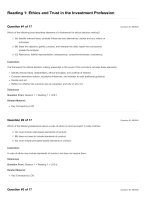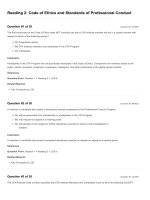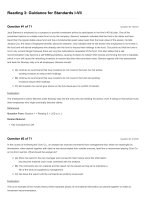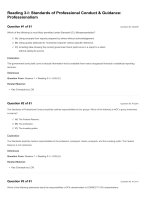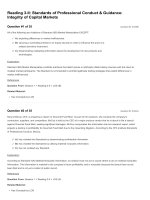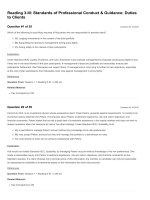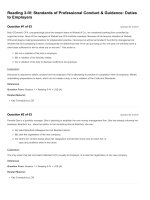39 2018 ielts1 practise minitest17 reading naturalworld
Bạn đang xem bản rút gọn của tài liệu. Xem và tải ngay bản đầy đủ của tài liệu tại đây (204 KB, 2 trang )
Khóa IELTS 5.0 - PRACTISE
GV: Hồng Hạnh
Facebook: HongHanhIELTSMoon.vn
IELTS COURSE 1
MINI TEST 17 – NATURAL WORLD
VIDEO và LỜI GIẢI CHI TIẾT chỉ có tại website MOON.VN
[Truy cập tab Tiếng Anh cho Tân sinh viên – Khóa: IELTS 5.0
ODONATA
Odonata is the order of insects that includes dragonflies and damselflies. To the human eye, their shining
colors and delicate-looking wings make them beautiful creatures to behold. In the natural world, however,
they are fearsome predators. Dragonflies and damselflies get their name from the powerful serrated jaws
they use to tear apart their prey. The word odonata means “toothed jaw.”
Dragonflies and damselflies are often confused with each other because they are very similar. Close
observation reveals the differences between them. The most obvious difference is the way they hold their
wings while at rest. Dragonflies hold their wings out to the side while damselflies fold their wings back.
Dragonflies have very large eyes that seem to cover the entire face because they are so close together that
they touch each other. Damselflies’ eyes are smaller, and there is a space between them. Dragonflies are
larger and stronger animals than damselflies and fly longer distances. Thus, they can be found in woods
and fields away from the water. Damselflies are not such strong fliers and are most often seen around the
edges of ponds and streams since they do not normally fly far from the water.
The largest odonata living today are the Hawaiian endemic dragonfly and the Central American damselfly,
each of these species having a wingspan of 19 centimeters. The smallest is the libellulid dragonfly, native
to east Asia, with a wingspan of just 20 millimeters. Fossils have been discovered that prove that
dragonflies have been in existence for over 300 million years. The largest dragonfly fossil ever found
belongs to the now-extinct meganeura monyi, which lived 300 million years ago and had a wingspan of 75
centimeters. This giant was a fearsome predator indeed, which feasted on small amphibians as well as on
other insects.
Dragonflies and damselflies both lay their eggs on or just below the surface of the water in a pond or
stream. Some species lay their eggs on the stem of an aquatic plant. The babies emerge from the eggs in the
form of nymphs. They live underwater, breathing through gills and preying upon water insects, tadpoles,
small fish, and even other nymphs. They hunt by hiding in the shadows at the bottom of a pond or stream,
waiting for prey animals to swim by. They have a special lip that they can extend far forward in order to
grab their prey when it comes close. Depending on the species, they live this way for several months or
even several years. As the nymph grows, it sheds its skin several times. Finally, it leaves the water and
sheds its skin one last time. The adult emerges, ready to live the next few weeks or months on land and in
the air. The adults do not live for more than four months, and many species live as adults for only a few
weeks. The exceptional visual abilities and flying skills of dragonflies and damselflies make them very
adept hunters. Their special eyes give them a nearly 360-degree field of vision, and they can detect even
the smallest movement or flash of light caused by other flying insects. They have two sets of wings that
can move independently of each other. This gives them great maneuverability in the air, which is important
to these creatures because they catch their prey while flying. They can hover, make sharp turns, and fly
Moon.vn - Học để khẳng định mình
1
Hotline: 0432 99 98 98
Khóa IELTS 5.0 - PRACTISE
GV: Hồng Hạnh
Facebook: HongHanhIELTSMoon.vn
backward. Some species of dragonflies can fly 60 kilometers an hour or more. Their prey consists of flying
insects such as mosquitoes, deerflies, smaller dragonflies, and butterflies and moths. One species of
dragonfly takes spiders out of their webs.
Bloodthirsty predators that they are, dragonflies and damselflies are prey for other animals in their turn.
The nymphs are eaten by fish, frogs, toads, and other aquatic creatures. In the adult stage, they are hunted
by birds, frogs, and larger dragonflies and damselflies. They might also be caught in a spider’s web. What
goes around comes around.
Questions 1 -6
Which of the facts below &we true of dragonflies, and which are true of damselflies. According to the
information in the passage? write:
A if it is a fact about dragonflies only
B if it is a fact about damselflies only
C if it is a fact about both dragonflies and damselflies
1.
2.
3.
4.
5.
6.
They have saw like jaws.
They hold their wings on their backs while resting.
Their eyes have a gap between them.
They can be seen in fields at a distance from ponds and streams.
The largest species has a wingspan of 19 centimeters.
The largest fossil has a wingspan of 75 centimeters.
Questions 7—13
Complete the notes about the life cycle of odonata below. Choose your answers from the box below and
write the correct letters, A—K
The eggs are laid 7 ________________. The young dragonflies and damselflies, called 8
_______________, live underwater for a few 9 _________________. They eat small water
animals, catching their food 10 ________________. When they are almost fully grown, they
leave the water. The adults live for only a few 11________________ . They are skillful 12
________________ and catch their prey 13 _______________ .
A. in the air
B. with their lips
C. tadpoles
D. fliers
E. near the water’s surface
F. nymphs
G. at the bottom of a pond
H. months or years
I. weeks or months
J. swimmers
K. with their wings
Giáo viên Hồng Hạnh
Nguồn
Moon.vn - Học để khẳng định mình
2
Moon.vn
Hotline: 0432 99 98 98



